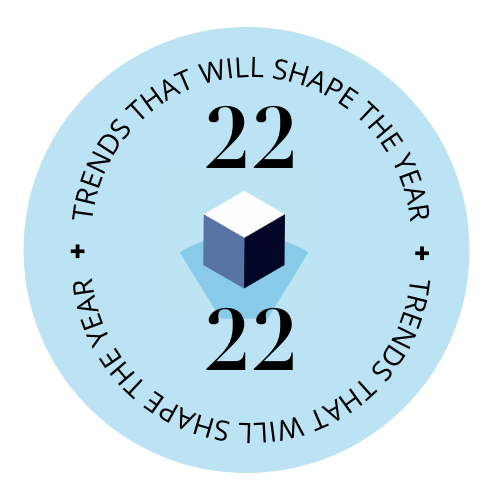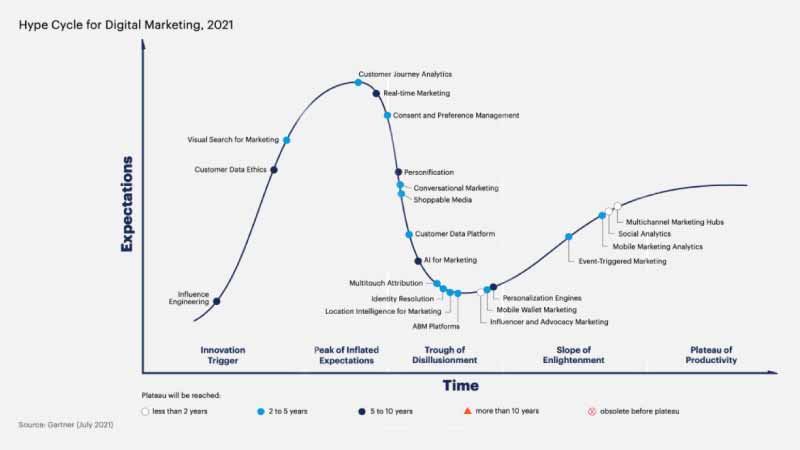22 Trends For 2022
What’s next? Defining trends shaping the future of marketing. Rising pressure for rapid growth coupled with market changes has forced many marketing teams to accelerate their digital transformation. At the same time, budget reallocation means innovative campaigns don’t have comfortable timelines to prove their business effectiveness. Innovating on a deadline can be tricky. Moreover, the […]
Topics
What to Read Next
- Martechvibe Launches the Marquee Awards to Celebrate Breakthrough Digital Campaigns
- Top Marketers 4X More Likely to Use AI, Consolidate Tech
- Roku and iSpot Bring Outcome-Based Optimisation to Streaming
- PMG Expands Influencer Marketing Capabilities with Acquisition of Digital Voices
- PayPal Ads Launches Transaction Graph Insights & Measurement

What’s next? Defining trends shaping the future of marketing.
Rising pressure for rapid growth coupled with market changes has forced many marketing teams to accelerate their digital transformation. At the same time, budget reallocation means innovative campaigns don’t have comfortable timelines to prove their business effectiveness. Innovating on a deadline can be tricky. Moreover, the initial enthusiasm among teams dies down.
This is exactly what Gartner found in their Hype Cycle for Digital Marketing. It is time for marketing teams to evolve or die but choosing where professionals direct their efforts will decide between success and failure. There is a lot to be proud of — marketing has become one of the most data-driven functions in organisations today. It is about adapting to changing market conditions and evolving alongside changing consumer behaviours. Marketers need to pick trends that matter to their industry, survive past being a fad and follow through on plans with flawless execution to stay ahead of the curve.

Image credits: Gartner Hype Cycle
-
Artificial Serendipity and Service
Traditionally, marketers like to make sure that customers can easily find the products and services they are looking for. Steven Van Belleghem, the author of multiple international best-selling books, including The Conversation Manager, When Digital Becomes Human, Customers the Day After Tomorrow and The Offer You Can’t Refuse, says that’s a no-brainer. He suggests the next wave of prediction will be suggestions driven by AI to offer the next level of discoverability. Research by the University of Sydney, University of Florida, and Rutgers University recently uncovered that serendipity and seemingly random discoveries can play a huge role in customer satisfaction. It’s not just theory. Research by Facebook in 2020 uncovered that 63 per cent of global shoppers enjoyed discovering items they weren’t actively looking for. “Today’s consumers are almost drowning in a sea of (information about) products. The “magic” that comes with finding something unexpected has almost completely disappeared,” said Belleghem.
Manish Mishra, Head of MEA Business at Freshworks echoes this thought. “Customer experiences will move from automation to prediction. The conversation on AI in CX has been around for a while,” he said.
AI has become an essential part of a winning CX strategy; from taking over manual activities from agents to helping them handle increased service request volumes, AI-powered chatbots are great efficiency tools. Now, businesses are starting to explore how their investment can go the extra mile to elevate customer and agent experiences. Smart bots can automate, smarter bots can predict customer behaviour, scale customer service and deliver delight.
-
On-demand Digital Humans will Take Over Concierge Services
The Internet of Things, AI and automation, will help businesses with repetitive tasks so human resources can focus on more valuable work. This is particularly relevant for the retail and hospitality sector. Consumers can expect self-serve kiosks, autonomous order fulfilment and AI-enabled chatbots to answer frequently asked questions. Take the example of UneeQ, a platform that uses lifelike AI and machine learning to create improved customer experiences through digital humans. In September, on the 100th anniversary of Albert Einstein winning the Nobel Prize for Physics, the company launched Digital Einstein, a realistic recreation of the scientist embodying his personality and knowledge powered by conversational AI. Einstein is more of a fit for edtech platforms but this illustrates the future of using digital humans as brand ambassadors to drive marketing engagement.
-
Physical Stores are the New Experience Zone
While everyone races against time to take their goods and services online, digital native brands are opening brick-and-mortar stores. The difference is that they are redefining the store to focus on engagement instead of being a physical selling point. The new purpose of this store is to create an unforgettable, immersive experience. Take for example, cosmetic brand Coty which uses augmented reality (AR) mirrors so consumers can try on make-up at their boutique in Paris. The store blends physical and digital experiences.
Brands are also using the stores with interactive displays to generate content from real users experiencing their product as a way to leverage social proof. Taha Iqbal, CMO, Toys R Us says this new way of looking at the store offers a better chance for localisation. The pandemic drove leading brands to reinvent to make opportunities where others only saw restrictions. At the KSA Toys R Us, store attendants used video streaming to offer an online shopping experience for customers stuck at home due to the lockdown. Consumers were escorted with an empty shopping cart across the aisles via Zoom video. “Conventional marketing could not be taken into account. It was time for innovation, for re-invention,” said Iqbal.
-
Trust is the New Equity
Tech regulators are reining in the power of tech giants that have grown unencumbered years, collecting data to train algorithms and build products. Even China is lashing technology giants like Alibaba and Tencent.
Experts say 2022 could be the year where big tech will finally be hit with significant new rules that will provoke significant battles. For example, the anti-trust lawsuit against Facebook (now Meta) represents a genuine threat to the social media giant. We expect more scrutiny and regulation will follow.
But it’s not about compliance, really. Customers want to feel like brands genuinely care about their privacy, but they also want personalised products made just for them. Brands that can straddle this dichotomy will foster loyal customers and come out on top.

Jill Grozalsky Roberson, Director of DX Product Marketing & Evangelism at Sitecore said, “When it comes to concerns about data management, brands need to strengthen their relationships with shoppers by putting them in control of their data and allowing them to control how much is shared and how it is used. Not only does this allow for positive consumer perception, but it also reduces concerns about data theft while still ensuring brands receive critical data needed for creating personalised experiences.”
-
Holograms To Rule Virtual And Hybrid Events
Hybrid events may have started as a business continuity solution to the pandemic-induced lockdowns, but they surprised everyone with the added benefits. For one, marketers could reach a wider audience and impact a global audience without worrying about multiple time zones. It worked great for knowledge sharing and thought leadership, but not for networking and experiences. Is it time to get back to physical events? Not exactly.
Recently, engineering researchers at Glasgow University developed a method for a person to be able to “touch” an object while interacting with quasi-holographic projections. Created with the aerohaptics system and volumetric display technology, one can “push” the object around. Professor Ravinder Dahiya said, “We believe aerohaptics could form the basis for many new applications in the future, such as creating convincing, interactive 3D renderings of real people for teleconferences.”
Can it solve the classic glitches of video conferencing? Cisco certainly thinks so. It launched Webex Hologram, a real-time meeting solution that utilises AR headsets. The hologram creates a photorealistic, real-time hologram that enables interactions that were previously possible only in in-person meetings. Recognising holograms as a collaborative tool, Cisco has been leveraging the technology on other occasions too. Recently, it unveiled The Cisco Grove, an immersive environment, at Expo 2020 Dubai. Guests explored the “Universe of Data” through a hologram-based experience. Rather than flying a technician to the racing team or explaining procedures through flat images, with the Hologram technology, we can immediately show an engine component from every angle, convey sizing, and instruct on assembly and usage as if they were in person – all while saving countless hours in travel time,” said Zak Brown, CEO of McLaren Racing.
-
It’s Time for Total Experience
Technology companies are realigning priorities. From winning customers to attracting top talent, trends have moved from customer experience to expanding its focus on employee experience. The two concepts have traditionally been treated as separate objectives. According to a Gartner report, organisations that shift to a more holistic approach will outperform competitors on key metrics. Total Experience combines the disciplines of user experience (UX), customer experience (CX), multi-experience (MX) and employee experience (EX) to create more extraordinary experiences. The goal is to identify intersections of stakeholders and improve the experiences of many instead of just one. The silos aren’t simply within the organisation, it seeps into the way an organisation looks outside. Imagine the kaleidoscope of views across the customer journey. Total Experience is a philosophy that hopes to change that fragmented view.
-
No-code will Give Relief from Skill-gap Challenges
Low code and no code options are a concrete step towards democratising data tools. With this capability, marketers need not wait to greenlight a campaign and observe their experiments in a secure sandbox-like environment. At the same time, marketing teams need not be dependent on their IT counterparts to make things happen. There are a ton of marketing objectives like targeting, creative analysis and generation, monitoring, optimisation, reporting and analytics that can bring value to the customer lifecycle. It may seem like a short-term solution but will definitely be significant in plugging the skill-gap problem for now. For example, SAP’s new platform includes a drag-and-drop interface, extensive component library and unlimited logic functions that can be used to create new web and mobile applications, enhance or extend existing software and automate complex development tasks.
-
Consumer Intelligence will Keep Brands Agile
 A consumer intelligence acceleration platform is an all-in-one solution that enables brands to be more agile and adaptive to change. Consumers are more demanding, more urgent, and more unpredictable than ever, says Elena Melnikova, Chief Marketing Officer at Talkwalker. It has become crucial for brands to leverage the billions of digital signals that consumers create online.
A consumer intelligence acceleration platform is an all-in-one solution that enables brands to be more agile and adaptive to change. Consumers are more demanding, more urgent, and more unpredictable than ever, says Elena Melnikova, Chief Marketing Officer at Talkwalker. It has become crucial for brands to leverage the billions of digital signals that consumers create online.
“Brands need to be proactive rather than reactive. To keep up with swiftly moving market dynamics, brands are establishing consumer intelligence frameworks that not only empower their marketing strategies but also design better products, make better decisions, and ensure a stellar customer experience at all touchpoints,” said Melnikova.
-
The Creative Revolution will Help Overcome Digital Fatigue
Blame it on the pandemic. Consumers are spending more time online where they are being bombarded with brand messaging. The era of the hard-sell has passed. Consumers can smell traditional marketing tactics and are growing averse to advertising. Instead, they are looking for products made specifically for them and brands that see them as a human being, not just a transaction. In 2022, brands will have to rise to deliver to these expectations via empathetic storytelling.
Jill Grozalsky Roberson, Director of DX Product Marketing & Evangelism at Sitecore said, “Marketers need to update their personalisation tactics and evolve from static personalised content to more creative formats. Marketers also need to embrace storytelling tactics to focus on empathy and how their brand fits with consumers’ values and beliefs. Brands and marketers need to look further than just products and connect with consumers through stories and thought leadership to highlight the human aspect of their company in a creative and engaging manner.”
There is a new breed of cloud-based creative software that can help deliver interactive stories at scale. Take for example, Fable, a motion design software that simplifies visual storytelling. In December, Fable announced its $15 million Series A funding round led by Redpoint Ventures, taking it to a total funding of $22.4M. Investor attention in such creative tools hints at an upcoming creative revolution.
-
Generative AI For World of Possibilities
Generative artificial intelligence (AI) will be applied more to figure out new insights about content or objects, as organisations don’t have to teach the model. It can create code, target marketing, identify new products and more. As organisations try to maintain unbiased recruitment processes and researchers to provide neutral results, Generative AI can also help in identity protection by maintaining the anonymity of individuals through avatars, and create new forms of creative content, such as video, and accelerating R&D cycles in fields ranging from medicine to product creation.
The technology can also help businesses deep-dive into their data to study trends easily and beyond traditional mathematical analysis.
-
There is Something for XaaS
The as-a-service model is popular for the variety of benefits it offers such as cost reduction, simplify IT deployments and guaranteeing a streamlined technology experience.
XaaS (Everything-as-a-Service) offerings is the next step. Marketers can expect to find the infrastructure they need to adapt to changes in product and service offerings at speed. Using multi-tenant approaches, cloud services can provide added flexibility as well. Resource pooling and rapid elasticity support via such tools allow businesses to simply add or subtract services as needed. A company can quickly access new technologies, scaling infrastructure automatically as and when users need innovative resources.
-
Martech Tools will Consolidate
The pandemic saw marketing budgets shrink for a brief period. While businesses bounce back, there remains greater scrutiny on tangible ROI from technology investments. Marketers will need to focus their attention on consolidating their stack to look for single solutions that can deliver multiple functionalities. The market continues to grow but vendors too are looking at integrating solutions to offer omnichannel functionality which has become a priority for brands. This not only helps reduce the costs but also allow for optimised use of first party data and better control over data governance.
-
Digital Media Spend Increases, Agency Spend Decreases
According to a Gartner report, CMOs have shifted spending commitments across their channels and programmes. Digital channels dominate and account for 72.2 per cent of the marketing budget. Moreover, the breakdown of budget across paid, owned and earned digital channels suggests the increasing importance of website, email, paid, organic search and social media which all gain a similar level of budget. Marketers no longer need to prove the impact of social media. Instead, they need to focus on creating a competitive edge over other players or risk losing market share.
-
The Future is Bright for Dark Stores
Careem Quik in the UAE is the latest entrant into the quick-commerce e-grocery service enabled by a hyperlocal dark store network. The defining formula here is that dark stores or micro-warehouses are located close to the point of delivery, manage a set of 1,500-2,000 stock-keeping units (SKUs) and use smart technologies and minimal human intervention to reduce the processing time for orders.
The idea of the dark store may have originated as a reaction to the pandemic and overcrowded aisles in supermarkets but it is here to stay. Going further, it can open up opportunities for grocers to open micro-fulfilment centres, grow the role of robotics in bagging and thereby reduce the overall turnaround time for deliveries.
-
Moving Towards Zero-Emission Delivery
The pandemic accelerated delivery robots, autonomous driving, remote-controlled delivery and micro-mobility vehicles. A recently published report estimated that market size and share for the delivery robots’ market is expected to reach $55 billion by 2026. Sustainability is a genuine challenge for last-mile delivery companies as they struggle to compete on increasing speed and lowering costs. In 2021, six major global logistics, eCommerce, and retail companies — Amazon, Walmart, Flipkart, UPS, DHL and FedEx — failed to set ambitious targets to carbonise in line with the 1.5-degrees goal, as per the study commissioned by Stand Earth and ASAR Social Impact Advisors.
But there is hope. In North America, GoFor launched its renewable delivery strategy to cater to customers who want rapid and low-cost same day delivery while dramatically reducing the environmental impact. The company’s sustainable business practices include delivery routes optimised for efficiency, drive times and fuel consumption lowered through carbon offsets, electric vehicles (EVs), smart technology and packaging. AI technologies can help optimise the use of non-renewable resources and reduce waste.
-
Monitor Core Updates and EAT
In June, Google announced a two-part Core Update which affected rankings for a lot of webpages. While it was built to weed out thinly-veiled content, it also had adverse effects on established brands and their web properties.
Each day the battle against spam rages on, Google usually releases one or more changes designed to improve our search results. Most aren’t noticeable but help us incrementally and continue to improve. Content teams will need to keep a close eye on updates that need action. The first step is to benchmark content and compare it against what Google deems relevant and crucial.
-
Verticalisation is Next to Localisaiton
Google is essentially using the local listing as a conduit for customised presentation of content that meets the searcher’s needs. Personalisation and verticalisation are closely connected and help differentiate the search experience. Retailers, hospitality and door-to-door services particularly need to take note. Google gives these categories a chance to represent their products with special focus on photo content and modifying the display of listings. It offers the customer prices and a comparison between other local players.
-
Inter-usability or the Multi-device UX
It’s bound to be an exciting year for user experience with the increasing focus on customer experience and meshing digital and physical platforms. User expectations are higher than ever. Consumers expect to be able to use apps, access websites across devices and continue where they left off; be it mid-conversation or halfway through a purchase. Sophia Prater, founder and lead UXer at Rewired suggests looking at devices as portals not products to ensure a consistent and contextual experience for platforms across devices. Before optimising the interaction design for each portal, UX designers must start by modelling the objects within the app’s environment. It doesn’t matter what the point of access is, the objects inside should be valuable, recognisable, and should match the user’s mental model.
-
Detractors will be Deadly for Brands
 According to David Noël, GVP EMEAR, AppDynamics, 73 per cent of UAE consumers, a whopping 16 per cent higher than the global average, say they are not prepared to give second chances to brands that disappoint them on the first try. This is, again, hardly a surprising finding, given the volume of choice within reach for consumers. Tolerance for poor digital experience has all but disappeared. And if an alternative brand manages to impress them the first time, then digital-savvy consumers will have no reason to return to the platform that irked them.
According to David Noël, GVP EMEAR, AppDynamics, 73 per cent of UAE consumers, a whopping 16 per cent higher than the global average, say they are not prepared to give second chances to brands that disappoint them on the first try. This is, again, hardly a surprising finding, given the volume of choice within reach for consumers. Tolerance for poor digital experience has all but disappeared. And if an alternative brand manages to impress them the first time, then digital-savvy consumers will have no reason to return to the platform that irked them.
-
Brands Need to Share to Keep Creators Close
According to a report by CBinsights, the creator economy has seen a record $1.3B in funding in 2021 alone. As a result, big social platforms are fighting to keep creators on their platforms to drive engagement. But creators, once at the whim of these gatekeepers, are looking for ways to monetise their posts more directly and earn a bigger slice of the overall revenue pie. Rodric David, CEO of Thunder said, “Achieving equity and fairness for creators will require a focus on preventing monopolistic big tech firms like Facebook from using their market dominance to continue the exploitation of creators as they have with the mobile internet.”
 Sean Cross, President and Co-Found of Display Social Inc said, “There is a convergence of discovery and eCommerce occurring among consumers, with demand for a seamless experience from discovery to purchase. Display Social believes everyone is a creator, and those creators are at the centre of our progressive, dividend-sharing platform. Brands now understand that to reach their audience and achieve revenue potential, they must have an authentic and endorsed presence among their consumer’s virtual lifestyle and social conversations,” said Sean Cross, President and Co-Found of Display Social Inc.
Sean Cross, President and Co-Found of Display Social Inc said, “There is a convergence of discovery and eCommerce occurring among consumers, with demand for a seamless experience from discovery to purchase. Display Social believes everyone is a creator, and those creators are at the centre of our progressive, dividend-sharing platform. Brands now understand that to reach their audience and achieve revenue potential, they must have an authentic and endorsed presence among their consumer’s virtual lifestyle and social conversations,” said Sean Cross, President and Co-Found of Display Social Inc.
-
Build a Metaverse-first Consumer Engagement Strategy
 Consumer loyalty to retail brands will be significantly disrupted by gamification. Currently, consumers make everyday purchases of goods and services without any expectation of additional and meaningful value being added to our transactions. “Consider, on the other hand, our typical purchase behaviour for airline tickets; many people are loyal to a particular airline because they are rewarded with frequent flyer points. Creators will soon be able to curate their individual style in customised virtual stores using an open metaverse distribution strategy,” explains Rodric David, CEO of Thunder. Their followers will be able to purchase real and virtual goods in the metaverse rather than a mall or a two-dimensional website and be rewarded in innovative ways that will encourage loyalty. Use the purchase of a pair of jeans as an example: a creator’s fan or follower visits the creator’s virtual store and purchases a pair of jeans in the metaverse, the physical jeans are delivered through a fulfillment provider, and the purchaser is rewarded with the same jeans as an NFT for use by their avatar. Creators will be able to reward their fans with other digital assets, discounts to live events or concerts, access to social meetups in the metaverse, access to live recording sessions, etc. Creators in the digital future will participate in and be commissioned on a far broader range of transactions.
Consumer loyalty to retail brands will be significantly disrupted by gamification. Currently, consumers make everyday purchases of goods and services without any expectation of additional and meaningful value being added to our transactions. “Consider, on the other hand, our typical purchase behaviour for airline tickets; many people are loyal to a particular airline because they are rewarded with frequent flyer points. Creators will soon be able to curate their individual style in customised virtual stores using an open metaverse distribution strategy,” explains Rodric David, CEO of Thunder. Their followers will be able to purchase real and virtual goods in the metaverse rather than a mall or a two-dimensional website and be rewarded in innovative ways that will encourage loyalty. Use the purchase of a pair of jeans as an example: a creator’s fan or follower visits the creator’s virtual store and purchases a pair of jeans in the metaverse, the physical jeans are delivered through a fulfillment provider, and the purchaser is rewarded with the same jeans as an NFT for use by their avatar. Creators will be able to reward their fans with other digital assets, discounts to live events or concerts, access to social meetups in the metaverse, access to live recording sessions, etc. Creators in the digital future will participate in and be commissioned on a far broader range of transactions.
-
Millennials will Drive Adoption of AR Experiences
According to a MoEngage report, the Middle East Asian market is one of the fastest-growing regions, marked by a young population (half of it sub-25) that is also digitally savvy. By 2025, the UAE will have an internet penetration of 96 per cent. Online retail sales are poised to grow by 20 per cent in 2022, outpacing brick-and-mortar sales. But there’s more. Consumption rates on Snapchat in the MENA region are often higher than the global average, with over 85 per cent of its MENA daily users interacting with Lenses every day. There is a greater comfort with using AR. This is a sure sign that the way we shop is about to change in the near future.
Take the example of American Eagle Outfitters, a brand that enjoys a younger audience, that launched a virtual pop-up holiday shop on Snapchat. The AR store allowed users to browse from among 15 to 20 pieces at a time. As shoppers physically moved their phones around their rooms, they were also exploring different areas of the digital store, where they could tap on certain products to learn more about them and create a wish list. At the end of the journey, users were prompted to go to American Eagle’s website to finalise the purchase. This two-step process is a chink in the otherwise impressive journey that blends virtual and real-world experiences. But it’s still a window into how AR will soon be mainstream and commonplace.
-
Supply-Chain Attacks Will Evolve
Supply chain attacks, such as the one used against Kaseya this year, show signs of maturing. While acknowledging that they are a relatively uncommon approach, a recent report by Abu Dhabi’s Digital14 identifies supply-chain attacks as one of the top threats faced by UAE organisations.
“In 2022, we should watch out for an expansion in scope and sophistication, with third-party solutions and well-known development practices being leveraged by attackers,” said John Hathaway, regional vice president, MEA at BeyondTrust.
Organisations need to include third-party supply chain breaches in their incident response plans and plan for a public and private response, just in case they become an inadvertent victim for a licenced solution.
If you liked reading this, you might like our other stories
The Evolving Customer Experience
Why Businesses Need To Master The Last Mile









































































































